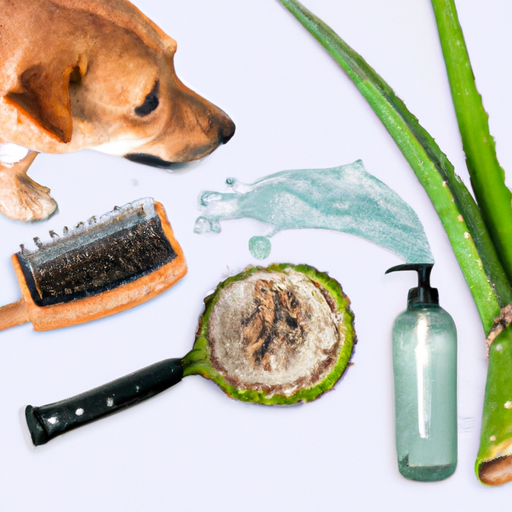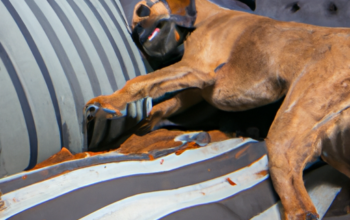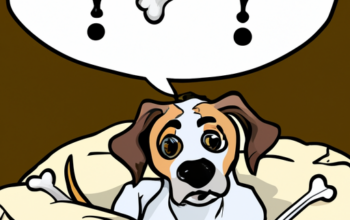‘Dandruff on my dog? That can’t be!’ you might exclaim. Surprisingly, it’s more common than you think and just like in humans, it’s treatable. Dandruff or skin flaking in dogs is often a symptom of underlying skin conditions which can be addressed with the right care and treatment.
This article serves as a comprehensive guide on how to get rid of dandruff on your furry friend. We’ll first delve into understanding the causes behind this issue, followed by regular grooming practices that aid in reducing dandruff. We’ll also discuss dietary adjustments for enhancing your dog’s skin health and use of medicated shampoos specially designed for canine dandruff treatment. Lastly, we’ll guide you through when to consult with a veterinarian for professional help.
So don’t fret! With consistent effort and patience, you can help your pooch achieve a healthy, dandruff-free coat once again.
Understanding the Causes of Skin Flaking
Before you can tackle your dog’s dandruff problem, it’s essential to understand what might be causing their skin to flake in the first place. Dandruff in dogs, similar to humans, is often caused by dry skin. However, it can also be a sign of an underlying health issue like allergies, parasites, or hormonal imbalances.
Flaking triggers vary and may include environmental factors such as low humidity or seasonal effects. As winter rolls around, the air becomes drier; this can cause your dog’s skin to lose moisture, leading to excessive shedding of dead skin cells and hence dandruff.
Furthermore, poor nutrition or lack of grooming could contribute to the issue. Always consult with your vet if you notice a persistent case of dandruff on your furry friend.
Regular Grooming Practices
As the saying goes, ‘an ounce of prevention is worth a pound of cure,’ so it’s crucial that you’re regularly brushing your furry friend’s coat to maintain its health and shine. Brushing not only keeps the fur clean but also stimulates blood circulation, improving skin health.
Below are some grooming practices that can make a difference:
-
Brushing Techniques: Use brushes designed for your dog’s type of fur. Regular brushing removes loose hair, dandruff, and dirt while distributing natural oils evenly across their coat.
-
For short-haired breeds, use a bristle brush.
-
For long-haired breeds, start with a slicker brush followed by a comb.
-
Fur Trimming: Keep the coat trimmed to prevent matting which can trap dander.
Remember, regular grooming keeps your dog looking sharp and feeling good!
Nutritional Adjustments for Skin Health
Embracing a diet rich in essential nutrients can significantly enhance your dog’s skin health, ensuring a vibrant and glossy coat. Dietary supplements are an excellent way to introduce these nutrients.
Omega-3 fatty acids, for example, can help reduce inflammation and eliminate dandruff-causing dryness. Zinc and Vitamin E supplements also promote skin health by boosting collagen production.
However, while adjusting your dog’s diet, be mindful of potential food allergies which may exacerbate skin problems instead of alleviating them. Common culprits include beef, dairy products, chicken, and wheat. If you suspect your pet has a food allergy contributing to their dandruff problem, consult with a veterinarian to devise an appropriate hypoallergenic diet plan.
Remember that proper nutrition is key to maintaining your dog’s healthy coat free from dandruff.
Use of Medicated Shampoos
Incorporating the use of medicated shampoos into your dog’s grooming routine could significantly decrease flaking, according to experts. The shampoo selection is crucial; opt for brands that specifically target dandruff and contain ingredients like coal tar, salicylic acid, or sulfur.
Some veterinarians might even prescribe a stronger medicated shampoo if your dog’s dandruff situation is severe.
The application techniques play an equally important role in combating dandruff. Wet your pup thoroughly before applying the shampoo evenly across its body. Massage it into the skin gently but thoroughly to ensure maximum absorption and rinse off completely as residue can worsen dryness.
Remember, using these shampoos too frequently may dry out your dog’s skin further so always follow the instructions on the bottle or veterinarian’s advice.
Consultation with a Veterinarian
Should your pooch’s flaking problem persist despite your best efforts, don’t hesitate to seek professional help from a trusted veterinarian. Understand that dandruff could be indicative of underlying health issues which require thorough veterinary diagnostics.
A vet will typically:
– Conduct a comprehensive physical examination
– Possibly perform skin scrapings for microscopic analysis
– May recommend blood tests to rule out systemic conditions
Based on these findings, the vet will formulate an effective treatment plan tailored to your dog’s specific condition. This may include prescription treatments such as medicated shampoos or creams, oral medications, dietary supplements, or even changes in diet.
Remember, each dog is unique and what works for one might not work for another. Trust in the expertise of professionals when dealing with persistent dandruff problems in dogs.
Frequently Asked Questions
Can dandruff in dogs be a sign of other underlying health issues?”
Just like how a poor diet can affect human skin, dietary influences can lead to dandruff in dogs. Yes, it could be a sign of underlying health issues. Dandruff treatments often address these root causes.
Are certain breeds of dogs more prone to dandruff than others?”
Yes, some breeds are more susceptible to dandruff due to dietary influences and seasonal changes. Breeds with dense coats or those prone to skin conditions often have a higher risk of developing dandruff.
How does the age of a dog affect its susceptibility to dandruff?”
Just like humans, a dog’s age can affect its skin health. Older dogs, due to hormonal changes and dietary impact, may be more susceptible to dandruff. It’s crucial to consider these factors for optimal pet care.
Can a change in the dog’s environment lead to dandruff?”
Yes, a dog’s environment can indeed influence dandruff occurrence. Dietary influences like inadequate nutrition and seasonal changes, particularly dry winter months, can exacerbate skin dryness leading to increased dandruff production.
Can dog dandruff be contagious to other pets or humans?”
Dog dandruff isn’t contagious to other pets or humans. However, for dandruff prevention, it’s crucial to select the right shampoo for your dog’s skin type and maintain regular grooming habits.
Conclusion
In conclusion, battling your dog’s dandruff might feel like climbing Everest, but it’s not impossible. Regular grooming, nutritional adjustments, and medicated shampoos can work miracles.
Yet, it’s essential to consult with a vet for the best solutions. Don’t let your furry friend become a snowstorm of flakes! Stand up against dandruff and help your pup live their flake-free life.



